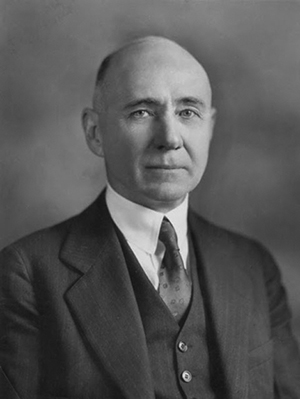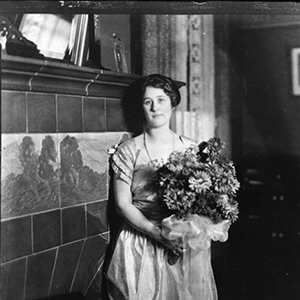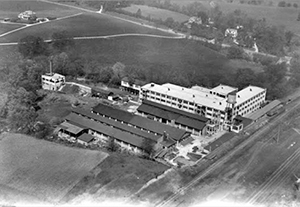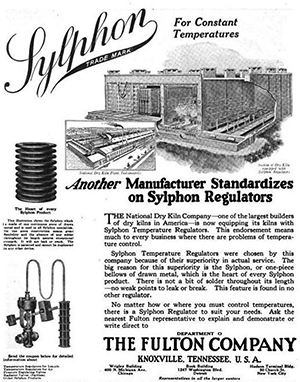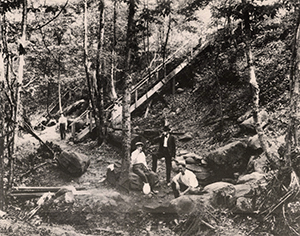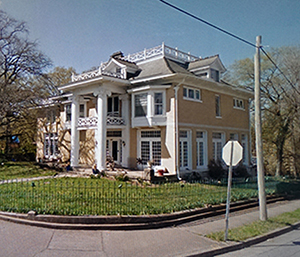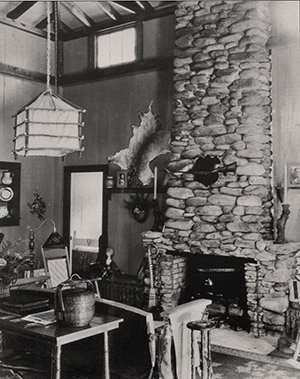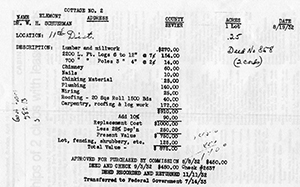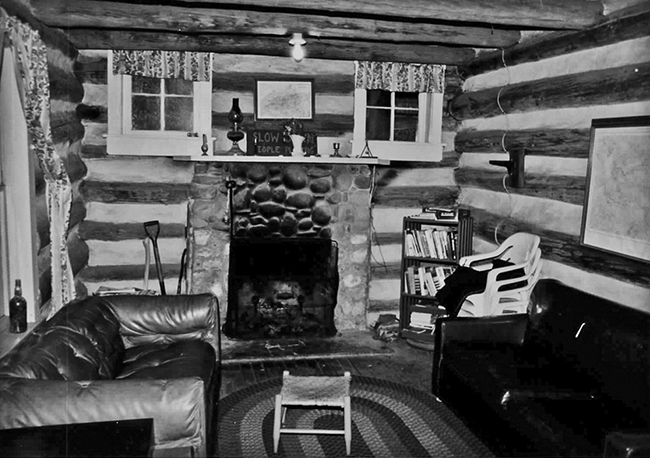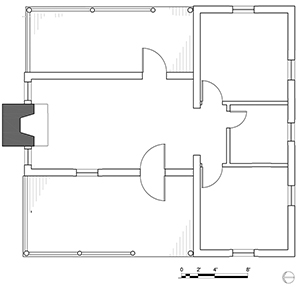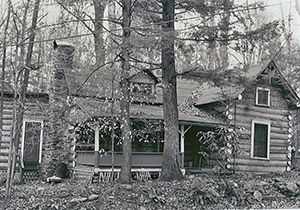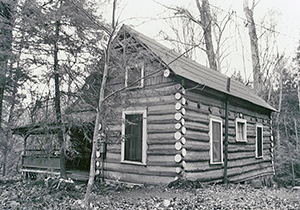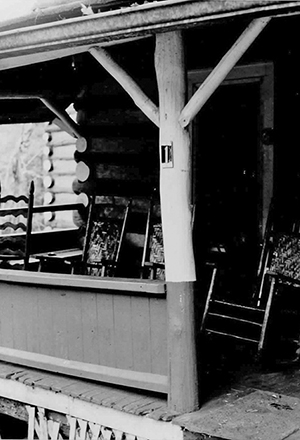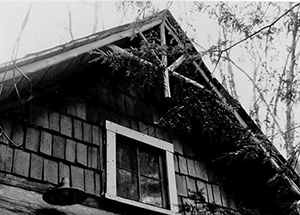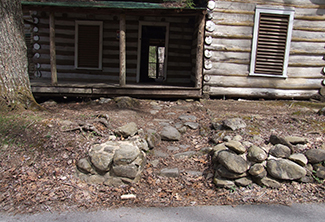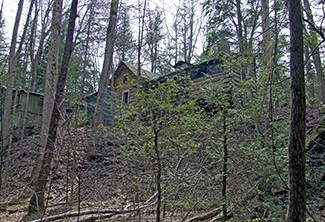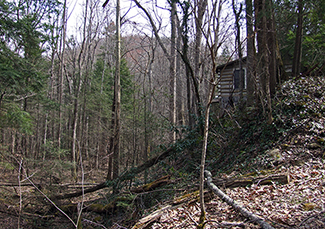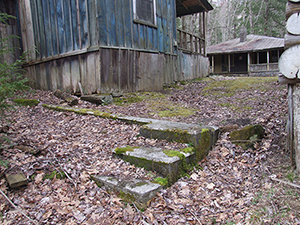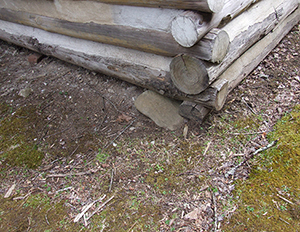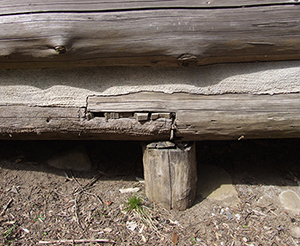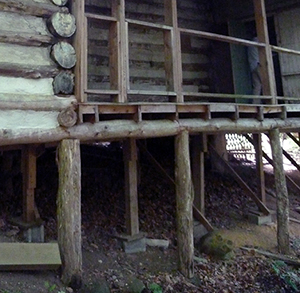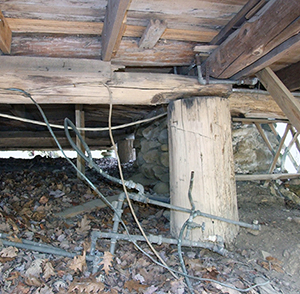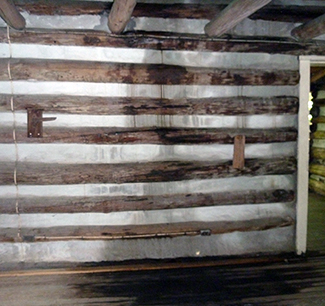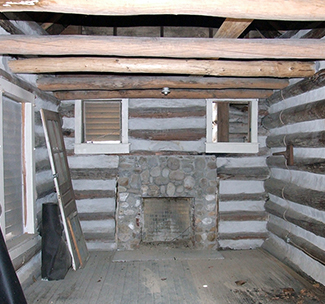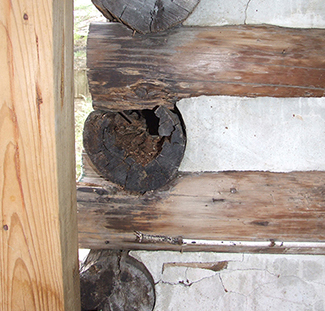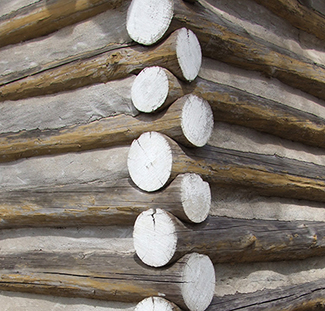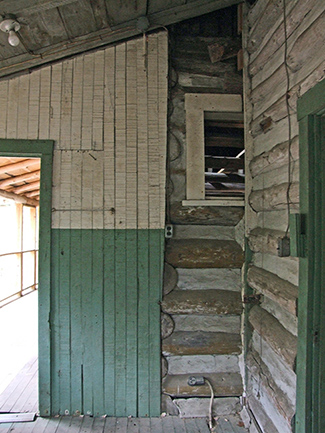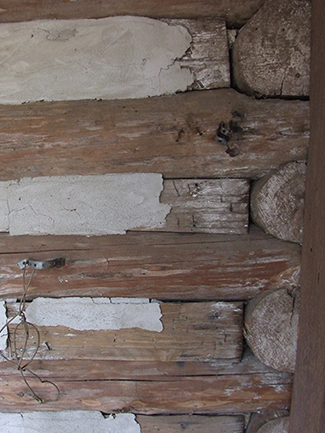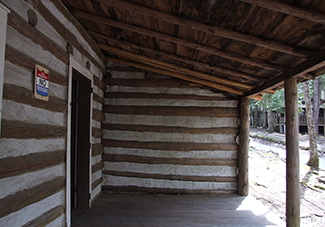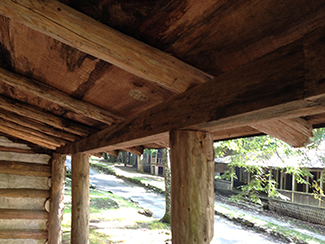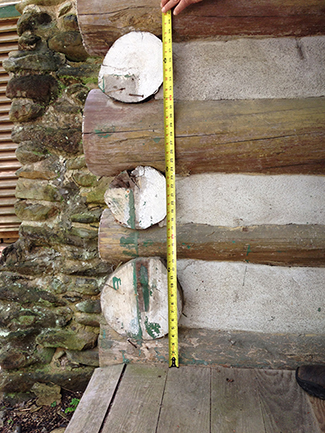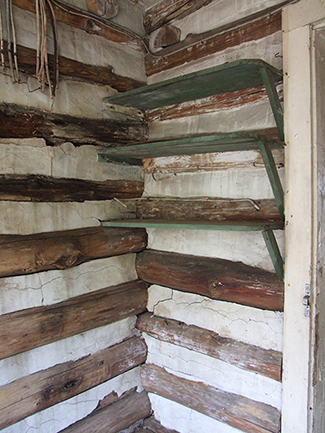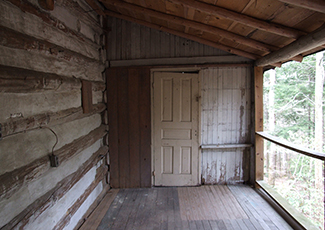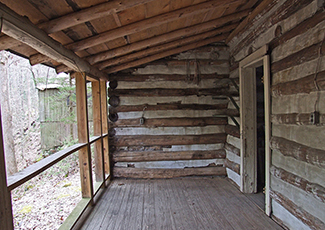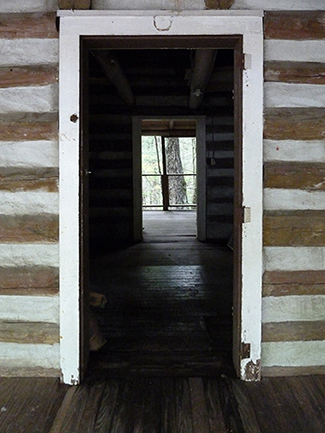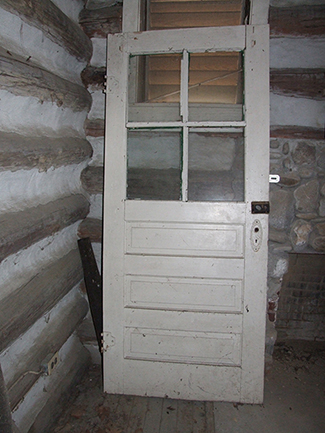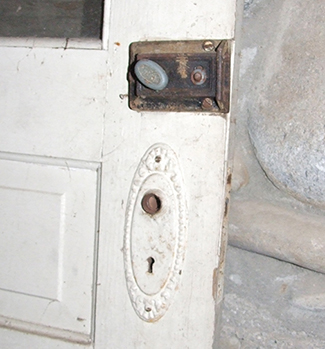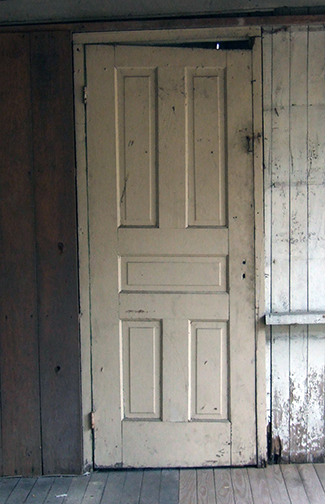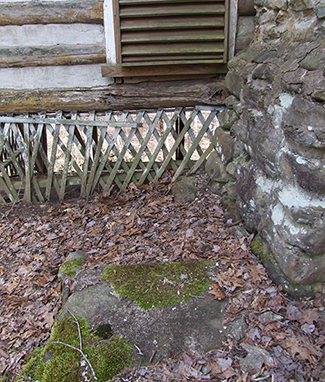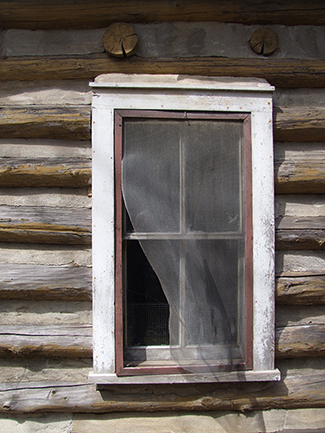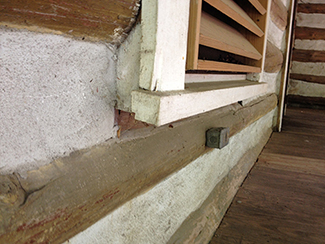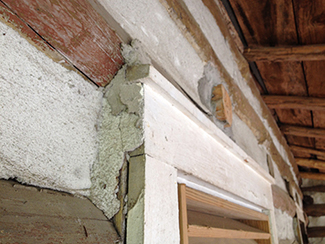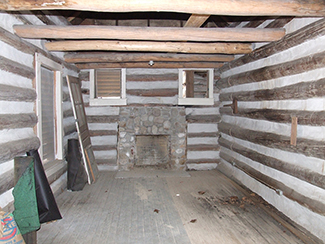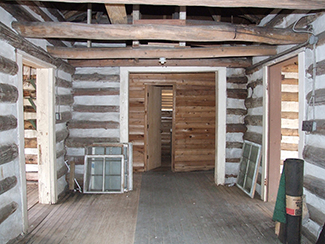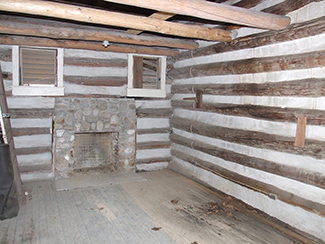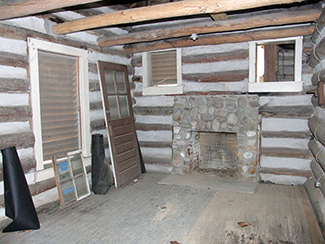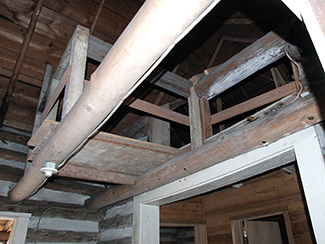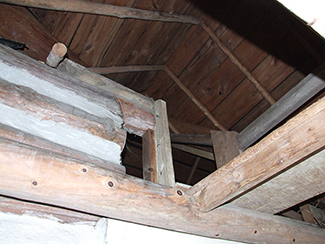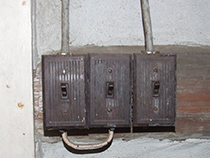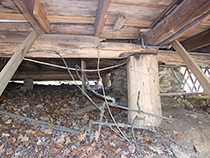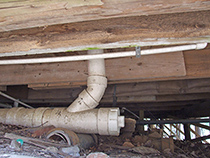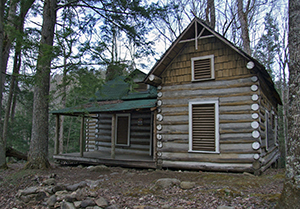
Figure 1. The Fulton-Sneed Cabin, 2014. |
|---|
In 1900 a group of investors from Pennsylvania incorporated the Little River Lumber Company and purchased 86,000 acres of virgin forest along the Little River in East Tennessee. The following year, they built a sawmill, around which the town of Townsend developed, and began construction of a railroad line to haul the vast amount of timber they had begun clearcutting from their tract of land, which stretched as far as Clingmans Dome. By 1908 the railroad extended eighteen winding miles to a small cove in the mountains where the company flung up a small town with a store, a hotel, and housing for the loggers. Such were the proximate origins of Elkmont.
Although built for industrial purposes, the railroad had connections to Knoxville and soon gained popularity as an excursion train, so much so that the company added a special passenger car. In 1910, several Knoxville businessmen organized the Appalachian Club as a sportsmen’s retreat and gained title to fifty acres along Jakes Creek just south of the logging town. Around the same time, some of Knoxville’s more-prosperous citizens began constructing summer cabins, one of which was the log Fulton-Sneed Cabin.
Log Buildings
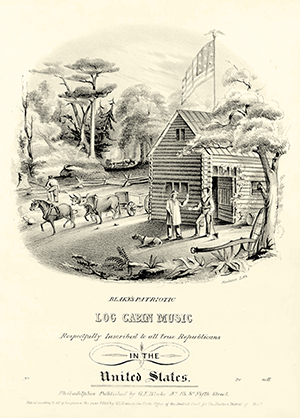
Figure 2. Cover sheet for William Henry Harrison campaign song, 1840. (Library of Congress) |
|---|
Growing out of centuries-old traditions in Scandinavia and central Europe, log buildings were common across heavily forested eastern North America through much of the eighteenth and nineteenth centuries. Historically there has been a distinction, not always recognized, between “log cabins” and “log houses.” “Cabins” were typically a single pen thrown up hurriedly with logs left in the round, often with a dirt floor. As a residence, it was temporary and soon replaced by a permanent, more finely finished “log house” built with hewn logs that were almost always eventually covered with siding or stucco.
Out of necessity, these frontier residences were built with logs, but as early as the 1840s, the frontier log “cabin” was becoming a part of the mythology of American life. Andrew Jackson was the first United States president to be born in a log cabin, and Abraham Lincoln the last. As the nation expanded westward in the nineteenth century, presidential aspirants courted the increasingly important frontier vote in a variety of ways, including associating log cabins with the simple virtues of frontier life. Even William Henry Harrison, who was born in a brick mansion in Tidewater Virginia, utilized the log-cabin theme in his successful presidential bid in 1840.
In the late nineteenth century, a rustic style of architecture began to evolve out of the log and stone buildings built in camps for the wealthy in New York’s Adirondack Mountains. As the national park system took shape in the late nineteenth and early twentieth centuries, rustic log and stone buildings typified park architecture, and by the time the Fultons built their log house at Elkmont shortly before World War I, log buildings had become hugely popular for the vacation retreats that were beginning to develop all over the southern Appalachians. Gustav Stickley, the great leader in the American Craftsman movement, promoted and romanticized log cabins when he wrote in 1912:
What is there about a log cabin, that seems so alluring and full of the suggestion of romance? Is it not because the house of logs is part of our heredity? It was a primitive home to man, a rudimentary sheltering of domestic life, a place of safety where love and friendship could be shut in and foe and danger shut out. [1]
Weston Miller Fulton
According to the National Register nomination for Elkmont, the Sneed Cabin was built by W. M. Fulton around the time the Appalachian Club was founded in 1910. Weston Miller Fulton Sr. (1871–1946) grew up in Clay County, Alabama, the son of William Frierson J. Fulton II and Mary Brown Hudson. He studied meteorology and graduated from the University of Mississippi as valedictorian in 1893.
After working in New Orleans and Vicksburg, he moved to Knoxville in 1898 to work at the National Weather Bureau station there but continued his schooling, earning a master of science in 1902 from the University of Tennessee. He married Barbara Murrian (1890–1971) on 17 August 1910. They lived at 1202 Clinch Avenue in Knoxville, just west of Second Creek, until they built a larger house at 820 Temple Avenue in 1913. They had five children. [2]
In 1903, Fulton invented a device for automatically recording water levels in the Tennessee River. Called a sylphon, the device is a flexible metal bellows that he soon found had a number of other uses, including in automobile thermostats. In 1904, he opened a factory at the east end of White Avenue in Knoxville and soon made a fortune. Shortly before World War I, he opened a new plant on Third Creek, a plant that under different ownership continued to manufacture sylphons until after World War II. He continued to tinker with his device and ultimately obtained over a hundred patents, one of which was for the trigger that made possible the depth charge, the Allies’ only defense against German U-boats in World War I. [3]
From 1923 to 1927, Fulton served two terms on the Knoxville city council and a single term as vice-mayor but is reported to have hated politics. In 1928, he built one of Knoxville’s great mansions, Westcliff, but the family had barely settled in when son Weston Fulton Jr. died from injuries sustained when he and some friends wrecked the family Packard on the Kingston Pike. Fulton donated the house on Temple Avenue to the University of Tennessee as a memorial to his son. [4] Fulton sold his company in 1930 and focused his energy on the W. J. Savage Company, manufacturers of flour milling and marble finishing equipment. He died in 1946 and his wife in 1971. Both are buried in Highland Memorial Cemetery.
The Fulton Cabin
Previous studies and the National Register nomination for the Elkmont historic district give “ca. 1910” as the date of construction of Weston Fulton’s log building. [5] Presumably it was one of the “forty or fifty” cabins that had been constructed by 1914. The Fultons must have built the log house at Elkmont shortly after their marriage in 1910 but precisely when and under what circumstances has not been documented, nor has the actual builder of the house been identified. Fulton is known to have been heavily involved with the construction of Westcliff, which was designed by Knoxville architect Charles I. Barber, and considering his other skills could have designed the cabin at Elkmont himself. The Fultons named their cabin Wild Rose. [6]
The design of the Fulton cabin incorporates some historic American log-building traditions, but a quick comparison with the nearby Levi Trentham Cabin (ca. 1830) shows the huge differences in design and craftsmanship between the two eras. Most obvious perhaps, the logs in the Trentham Cabin were carefully hewn and squared and put up using time-consuming but very strong half-dovetail joinery, leaving only narrow gaps between the logs. The Fulton cabin, in contrast, was built in the simplest way possible using peeled logs left in the round and put up with the shallowest of saddle notches. Traditionally, such construction was fit only for the most temporary of shelters or for housing livestock. Irregularly sawn lumber covered by concrete closed the large gaps between the logs. It is assumed that the expanded metal lath found in some locations is related to later repairs of this chinking.
Floor joists are sawn, but the exposed ceiling joists and rafters are peeled log poles. The original roofing may have been wood shakes, similar to those used in the gables, but that is not likely. The roofing could have been commercially sawn wood shingles or even asphalt shingles, which during that period were sold in a huge array of colors and patterns. An appraisal in 1932 describes the house with a wood deck and rolled asphalt roofing, which may well have been the original roofing material.
The original house consisted of the two rectangular log pens intersecting to give the house its T-shaped footprint, a needlessly complicated way of building compared to the traditional, and eminently practical, building of separate log pens, added side-by-side or separated by a dog trot. The small fireplace, multiple large window openings, and a difficult roof that also had dormers were all features not typically found in a nineteenth-century log house.
Shed-roofed porches have been partially rebuilt and, although both have lost their historic paneled balustrades, the two porches were apparently original features of the house. On the front porch, logs were used for posts to support the porch roof, each post having pole braces to the header. Only one original post and none of the braces remain intact. The balustrades visible in later photographs appear to have used nominally 2” by 4” or 5” boards to form top rails, which were set about 24” to 28” above the floor. What may have been a nominally 4” by 4” board was shaped to form the bottom rail. Upright between the two rails, tongue-and-groove boards, perhaps 1” by 5”, were installed in a rabbet in the bottom rail with something as simple as 1” quarter-round holding them in place at top and bottom. The balustrade across the back porch was paneled in a similar way, but also included screening above the balustrade. Opposite the back door, a screened door opened out to a landing and a flight of steps that descended to the south.
The three gables were finished with split wooden shakes; the front and rear gables retain decorative, vaguely Stick-Style trusses made from short lengths of peeled log poles.
Ceiling joists set about 18” below the top of the log walls tie the sides of the log pens together, and while the resulting exterior appearance mimics the appearance of a traditional story-and-a-half log house (i.e., with a main floor and joists set a couple of feet below the top of the log walls to accommodate a loft in the attic above), there was apparently no ceiling/attic flooring in the original structure. This gives the present living room something of the air of a rustic lodge and compensates somewhat for the relatively small scale of the rooms. Dormers front and rear of the main roof give much-needed daylight to that room, which has no window on the rear (east) wall. With bottom-hinged sash, the dormer windows could also help ensure maximum natural cooling of the interior.
The late twentieth-century bathroom obscures evidence for placement of historic partitions in the southern log pen, but it was almost certainly partitioned in some way to form at least two bedrooms. There was no need for a kitchen in the original cabin since, at least in the early days, three meals a day were served in the clubhouse.
The first residents along Daisy Town Road drew water from a spring down the hill behind the Higdon and Addicks cabins, just south of the Sneed Cabin. Between the Sneed and Higdon cabins, the concrete steps that remain at the road and at the rear of the cabins most likely led to a wooden staircase to the community spring. [7]
The original house could have had a rudimentary bathroom although privies were also common in the early days. [8] The framing and casement of the existing bathroom window dates to the late twentieth century and makes it impossible to determine whether it was an enlargement of an earlier opening. A single, six-light sash is visible in the opening in 1993 and 2001 photographs, but that might not be an original feature since all of the other sash have only two or four lights.
The placement of the bathroom itself leaves the windows on the south side of the bedrooms very much off center in each bedroom. Without a bathroom and bathroom window, the fenestration on that side of the house would appear more rational. However, the 1931 appraisal of the house included a substantial amount for plumbing so, presumably, a bathroom was present by that time. The present bathroom, which dates to the 1970s, obliterates all evidence of any earlier bathroom, except for the broken stub of a 4” cast-iron waste line visible in the crawl space below. A 2” cast-iron vent stack is also visible in photographs made in 1993 and 2001 but has since been removed. Its placement suggests that it might have serviced a basin in the southeast corner of the front bedroom.
In 1919, the Appalachian Club reconstituted itself as the New Appalachian Club and conveyed title to the cabins to individual owners. Weston and Barbara Fulton took title to the log house and about a quarter acre of land on Lot #3, but the following year, for unknown reasons, sold the property to W. H. Schuerman. [9]
The Schuerman-Criddle Cabin
The son of Prussian immigrants, William Henry Schuerman (1859–1932) was born in Cincinnati, Ohio, where he grew up and went to public school before graduating with a degree in civil engineering from the University of Cincinnati in 1881. Two years later he received his PhD at Johns Hopkins University and shortly thereafter was named assistant professor of physics and engineering at Missouri State University. [10]
In 1888, Schuerman quit teaching in order to work as chief draftsman in construction of the Covington, Kentucky, waterworks. In the early 1890s, he managed construction and operation of the Kern County, California, system of irrigation canals. He is also credited with design and construction of sewer systems in Oxford, Mississippi, and Monroe, Louisiana. In 1894, he began his career at Vanderbilt University and the following year was named dean of the university’s School of Civil Engineering, a position he held until his death. [11]
The maiden name of his first wife, Mary, is not known but the Federal census shows they married in 1888. No children were recorded in the household in the 1900 census. By 1910 the couple had divorced, and William Schuerman was renting a room on the Vanderbilt campus. The following year he assumed additional duties when he was named acting dean of the School of Arts and Sciences, a position he held until 1914. By then he had met a wealthy widow, Leonora Badger Criddle (1872–1955). [12]
Criddle was born Leonora “Nora” Badger and grew up in Nashville, where her father, Felix Badger, was a dentist. His heritage is thought to have been partly Cherokee. Around 1890, she married William Smith Criddle (1841–1909), a prosperous Nashville merchant and “capitalist” thirty years her senior. With him she had five sons—Barrington, William Jr., Felix, Edward Scruggs, and Brexton Whitfield—before his death from typhoid fever in July 1909.
On 12 July 1914, Nora Criddle married Dr. Schuerman. [13] The Schuermans’ primary residence was a large Classical Revival mansion, probably built not long after their marriage and located at 1800 Cedar Lane in Nashville’s suburbs a mile south of the Vanderbilt University campus.
In 1928, perhaps cramped for space in their first Elkmont cabin, the Schuermans acquired a second lot, located in Millionaire’s Row right on the Little River, and built a large wood-framed house that they called The Wigwam. [14] It is not clear how their old cabin in Daisy Town was used, but it may have been rented.
The Schuermans continued to own two cabins in the spring of 1931 when the Federal government began appraising the property at Elkmont in anticipation of its acquisition for incorporation into the new Great Smoky Mountains National Park. Summaries of the appraisal of each property at Elkmont are preserved on typed index cards and include two cards associated with the Schuermans. [15] Although the information on the two cards is somewhat muddled, the separate appraisals appear to account for the log house in Daisy Town and The Wigwam, the Schuermans’ cabin on Millionaire’s Row. In the appraisal for the Daisy Town cabin, Schuerman claimed ownership of a quarter acre of land. Replacement cost for the cabin itself was estimated at $1,000.
By that time there was almost certainly indoor plumbing, probably including a bathroom and a kitchen sink. [16] The kitchen remains much as it was built with doors on the south and west walls and windows on the north and east. Scorched flooring and the closed holes for a flue through the log walls and into the chimney suggest that cooking was done on a wood-fired stove set in the southwest corner of the room.
As noted above, evidence for details of more than the approximate location of an earlier bathroom were obscured by construction of the present bathroom. It could have been simply a toilet and lavatory, or a full bathroom with cast-iron, footed tub, such as that documented at contemporaneous cabins in Daisy Town.
By 1931, too, electric lights replaced the kerosene lamps that were used in the first decade or so of the cabin’s existence. The lights were probably limited to a basic porcelain lamp base with a bare bulb, and there were no convenience outlets. Not until the early 1950s when commercial power was extended into the community was 220-volt wiring for a stove possible.
It may have been during the Schuermans’ tenure that a small wooden awning was installed at the north end of the front porch. It consisted of a simple shed roof, with a wood deck and asphalt roofing, supported by pole brackets similar to those installed at the front posts. It was apparently added to compensate for the lack of an overhang at that end of the porch.
Negotiations for purchase of private property for the proposed national park dragged on and not until 8 August 1932 did the commission overseeing land acquisition for the park finally approve purchase of the Schuermans’ cabin on Daisy Town Road for $450. It was less than half the original value, but in exchange the Schuermans, like many other Elkmont residents, obtained a life-time lease on the property.
Three days later, on 11 August 1932, Dr. Schuerman drowned in the Little River. Less than a month later, his widow and her sons by her first marriage conveyed title to their cabin in Daisy Town to the State of Tennessee for inclusion in the national park. On 14 July 1933, title was transferred to the Federal government. [17]
The Sneed Cabin
Who held the first lease on the Schuermans’ cabin under Federal ownership is not clear, nor is it clear when the Sneeds acquired a lease on the property or whether there were previous tenants. If major changes were made to the cabin before World War II, evidence has been mostly obliterated by late-twentieth-century repairs and alterations.
The Appalachian Club’s hotel and clubhouse burned in 1933, along with all of its records, but was rebuilt the following year, the same year Great Smoky Mountains National Park was formally established. A CCC camp was built on the site of the old logging town of Elkmont and the National Park Service made improvements to the water and sewer system in the 1930s and 1940s. Electricity was still only available for two hours each evening until commercial electrical service was extended to Elkmont in 1952. In exchange, owners of the cottages gave up their lifetime leases for a fixed 20-year lease.
|
Figure 11. The living room of the Fulton-Sneed Cabin, 1993. (Thomason and Associates) |
|---|
The date that the bathroom was replaced is uncertain. The PVC waste lines, fiberglass fixtures, hollow-core doors, and the cedar paneling used on all of the new walls is characteristic of the 1970s. The cabinets, formica countertop, and the 220-volt stove outlet in the kitchen may be more or less contemporaneous with the bathroom.
As already noted, ceilings were not a part of the house’s original design, and so there was no loft. In the last quarter or so of the twentieth century, a barely usable loft was created over the bedrooms and bath. It was accessed by a ladder, now missing, leading up to an improvised landing near the southeast side of the living room. Three-foot sections of the three logs at the top of the wall between the two log pens were cut out to ease access into the loft that was then created by laying 4’ by 8’ sheets of plywood, ¾” thick, across the widely spaced log joists above the bedrooms and bath. The final features that might be noted, albeit not perhaps historic, are the 6” K-style gutter and the brick steps at the front porch visible in photographs. The gutter appears to have been installed only over the front steps. No downspout is visible in the historic photograph, and it is likely the gutter was installed to direct rainwater run-off away from the front steps. The two brick steps spanning the opening to the front porch were laid flat in a stack-bond pattern and probably replaced wooden steps.
The Recent Past
Most of the leases on the cabins in the Appalachian Club complex expired in 1992; all leases expired by 2001. The park’s General Management Plan (GMP) in 1982 called for the demolition of all structures at Elkmont and return of the sites to a natural state. This contributed to the general lack of maintenance of the cabins. By the early 1990s, private efforts to preserve Elkmont were organized, and in 1994 the Elkmont Historic District was listed in the National Register of Historic Places with a period of significance of 1908–1940. Recent study suggests that 1952 might be a more-appropriate end date.
In 2001, the park contracted to have the Daisy Town cabins, ancillary structures, and the Appalachian Club’s clubhouse photographed to the standards of the Historic American Buildings Survey (HABS). As many as fifteen images were taken of the Sneed Cabin. Although the cabin was in poor condition, most of its historic features appear to have remained intact, including the posts and balustrades on both porches, features that have since been removed.
Consultation with the SHPO under Section 106 of the National Historic Preservation Act resulted in a determination that the proposed demolition of Elkmont constituted an “adverse effect.” With the support of the National Trust for Historic Preservation, the Advisory Council on Historic Preservation, and the Tennessee State Historic Preservation Officer (SHPO), the NPS revisited the issues at Elkmont in an Environmental Impact Statement (EIS), drafted in 2006 and finalized in 2009, which modified the demolition proposal to allow for the preservation of some of the historic structures in the district. One of those being preserved is the Sneed Cabin. [18]
Once it was clear which of the Daisy Town cabins would be preserved, the National Park Service conducted a number of basic repairs. At the Sneed Cabin, these repairs included replacement of the front-porch floor and removal of the historic balustrades and posts. Rafters and roof decking were entirely replaced on the back porch as were joists and flooring at the south end of the porch. The historic paneled balustrade, screening, and the exterior landing and steps to the ground were lost at that time. Some repairs were made to the roofing as well. and a wooden awning was removed from the north end of the front porch. Repairs were made to the log walls around the southwest corner of the house, which required replacement of some of the flooring in that part of the front bedroom. Nearly half of the flooring in the living room was replaced as well. Several window sash have been removed but remain in the house. Louvers to allow continuous ventilation have been installed at some windows. Historic doors have been removed from their frames, but the front doors, along with the screened door for the kitchen, remain in the house. The electrical service entrance on the front of the house and the breaker panels at the south end of the back porch have all been removed. There is no kitchen sink and no running water in the house.
 |
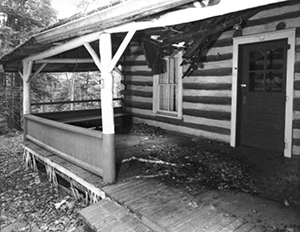 |
|---|---|
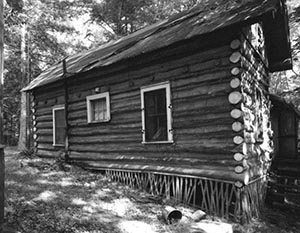 |
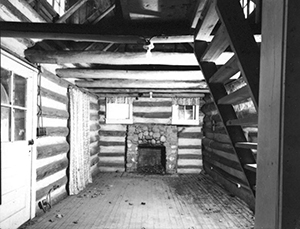 |
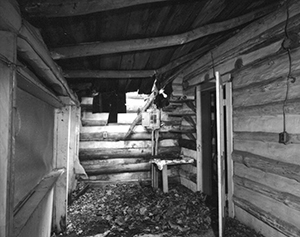 |
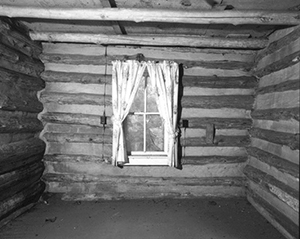 |
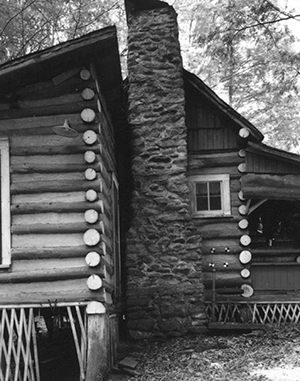 |
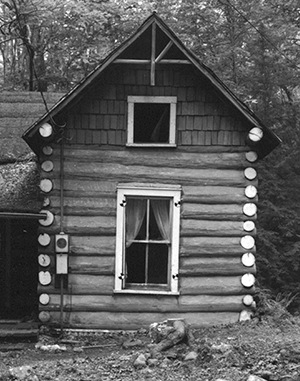 |
|
|---|
Site and Building Descriptions
Located near the northern end of Daisy Town Road, the Sneed Cabin is on Lot #3, a quarter acre about two hundred feet south of the Appalachian Club's historic clubhouse (1934). Facing west, it is the northernmost in a row of rustic summer cabins on the east side of the road.
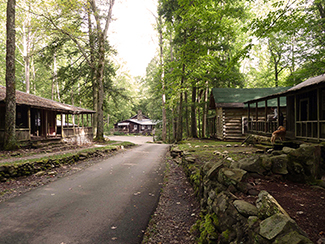
Figure 25. Daisy Town Road, looking north toward the Applachian Club, with Fulton-Sneed House on the right just beyond the Boykin-Higdon Cabin. |
|---|
The cabin is one of eighteen historic structures that survive of the several dozen buildings built at Elkmont in the early twentieth century. A contributing building in the proposed Daisy Town Community National Register Historic District, the house is known today by the family name of the last lease-holder of the property.
Dating to the second decade of the twentieth century, the cabin is a one-story log structure occupying a footprint of about 1,114 square feet, including the porches. The present building includes the original three-room house with its T-shaped plan and gabled roof as well as shed-roofed porches on the front and rear.
The shed of the rear porch roof extends over an early kitchen addition at the north end of the porch. Between the two rooms on the south side of the house is a modern bathroom that apparently replaced an early twentieth-century bathroom in the same location.
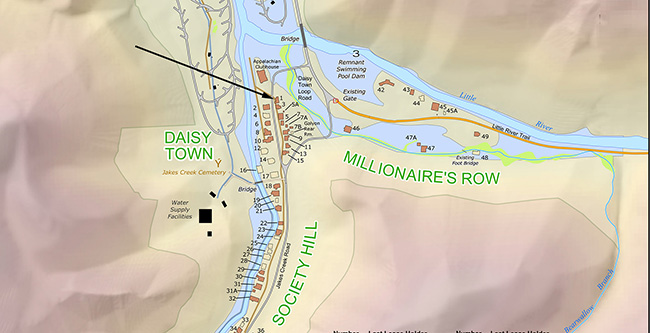
Figure 26. Detail from topographical map of Elkmont, annotated with an arrow to locate the Fulton-Sneed Cabin. (NPS) |
|---|
Site
The Sneed Cabin is located near the end of the long plateau that descends between Jakes Creek on the west and Bear Wallow Branch on the east, just a few hundred yards south of where those two streams join the East Prong of Little River. The cabin fronts on a spur of Jakes Creek Road that runs along the spine of the plateau and is now part of a narrow, one-way drive through the historic Appalachian Club portion of Elkmont. The site slopes gently from north to south but also has a steep, rocky drop of over twenty feet to Bear Wallow Branch on the east (rear) side of the property. There appears to have been little effort given to leveling the site before construction of the building.
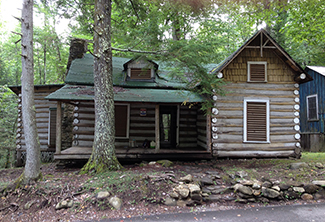
Figure 27. The Fulton-Sneed House, looking to the east. |
|---|
The cabin is set about fifteen feet from the road, with a low, mostly dry-laid stone retaining wall separating the front yard from the roadway. Consisting of river stone that was no doubt locally sourced, the wall may have originally extended the entire width of the property but only a few scattered stones remain on the north (left) side of the front entrance.
Near the center of the lot what appear to have been two or three stone steps and a series of stepping stones lead from the road to the front porch. All of these features use similar river stone with its characteristic smooth surfaces and rounded edges.
Just off the southeast corner of the cabin, TRC Garrow Associates' cultural resources survey (2004) identifies three concrete steps that the report associates with the Sneed Cabin. [19] Those steps remain in place, each step about 7" high, 12" deep, and 34" wide and each finished with broadly beveled outside edges.
Running south from the corner of the top step is a concrete curb that is likely contemporaneous with the steps but that was not recorded by TRC Garrow's 2004 report. The curb, which is about six inches wide and has the same broadly beveled edges as the steps, continues just above grade for several yards behind the neighboring Higdon Cabin. The curb likely edged a walkway of some sort that led from the back door of the Higdon Cabin to the concrete steps near the Sneed Cabin. In line with these steps, another series of steps rises from the road near the northeast corner of the Higdon Cabin's front yard. As noted earlier, all of these features may have been associated with a walkway that provided access to a wooden staircase down to the spring behind the Higdon and Addicks cabins. In front of the doorway on the west side of the kitchen is a large flat stone, perhaps 24" by 30". While it may have been a natural feature, the stone was likely moved to give a footing for five wooden steps that originally descended from the kitchen door.
Foundation
The log walls of the cabin are set on rock piers and wooden posts that, like most historic log buildings, appear to have no below-grade footings. Sills along the west (front) side of the house are set mostly on large flat stones placed directly on the ground, with additional stone stacked as necessary to meet the grade that falls away from southwest to northeast. At the southwest corner of the cabin, the sills at the south end of the front porch are within inches of the ground, but the ground falls 12" to 18" toward the north end of the porch and the northwest corner of the original log pen. Across the rear, the cabin is elevated around 36" above grade at the southeast corner and 68" at the northeast corner.
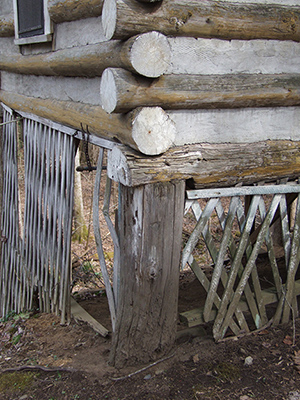
Figure 32. Foundation post and typical lattic like that which originally enclosed the perimeter of the foundation. |
|---|
Most of the center and east side of the house rests on wooden posts set on flat rocks placed directly on the ground. In some cases, the wooden posts themselves appear to have been set directly on the ground or else the associated rock footing has been buried by eroded material. All of the historic posts are log, ranging in diameter from 4" to over 15". Many of the posts are still with their bark and at least some are black locust (Robinia pseudoacacia), indigenous to the southern highlands and renowned for its resistance to rot and insect damage.
In recent repairs, a series of seven 3½" by 5½" sawn posts set on 8" by 12" concrete block have been installed to support sawn beams, 3½" by 7¼", added mid-span of the floor joists down the long axis of the back porch and kitchen. Contemporaneous with those are the diagonally installed braces, nominally 2" by 4". The house's foundation is completed by the original log beams that are set on these posts and rock piers. These run north to south underneath the outside wall and back porch at the rear of the house.
A diamond-patterned lattice, painted white, at one time concealed the entire foundation but is now missing across the front (west) and rear (east) sides of the house. Most of it remains intact, although in very poor condition, along the north side of the house, and a small section remains at the east end of the south side.
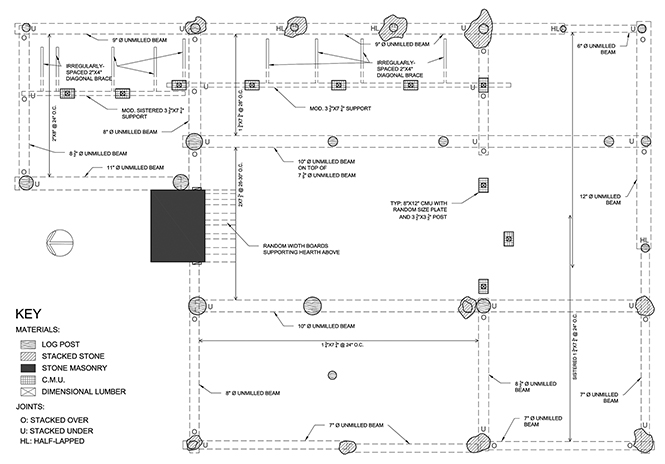
Figure 37. Plan of rock piers and wooden posts forming the foundation for the Sneed Cabin. See the Appendix for full-size drawings. |
|---|
Log Walls
The species of the logs used in the walls has not been determined but is likely hemlock, pine, and poplar. All of it was likely timber cut around Elkmont. In the original part of the house, logs range from around 7" in diameter to over 10" with one log along the south side of the house measuring a little over 12" in diameter.
Twelve logs make up each of the walls in the original cabin, except on the west wall of Room 102 and the north wall of Room 101 where only eleven logs are present. The stacked logs create two intersecting log pens and the house's basic T-shaped floor plan. The largest pen forms a long rectangle 30'-2" west to east and around 12'-2" north to south. The smaller pen is around 12'-8" west to east and 20'-0" north to south.
Tying the long walls of each pen together are cross beams inserted between the eighth and ninth logs and running perpendicularly between the long walls. Generally 7" to 8" in diameter, they create joists for a ceiling or attic flooring that appear not to have been part of the cabin's original construction, in part no doubt due to the labor necessary to flatten the tops of the logs enough to install flooring.
Kitchen Addition
The kitchen wing, which was probably added in the 1920s, is essentially a three-sided log pen, with its fourth wall created by a board wall at the north end of the original back porch. The west wall of the kitchen terminates in the middle of one of the small windows at the north end of the original cabin.
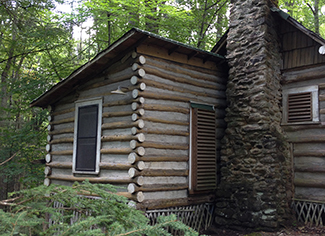
Figure 44. The north end of the house and its kitchen wing. |
|---|
The wing uses nine logs on the east wall and twelve on the west, with the north wall including nine whole logs plus two partial logs to fill the half gable on that end. The logs in the kitchen walls are 6" to 8" in diameter, significantly smaller than those used in the original construction.
The gaps between all of the logs, as much as 5"-6" in some cases, could not be simply chinked without the addition of other material. To fill the interstices in the log walls, rough-sawn and split lengths of lumber were nailed in place to serve as a sort of lath for the hard, Portland cement used for the final chinking. The sawn ends of all of the cabin's logs have been painted white, a traditional way of providing some protection against water penetration on the rot-prone log ends.
Cement chinking between the lower two logs on the outside of the east wall of Room 106 appears to have been completely replaced or it may simply have been covered by a skim coat of cement. Much of the chinking on the interior of the walls of the south log pen appear also to have been heavily repaired. In isolated locations, expanded metal lath has been used for repairs to the chinking.
Splices in the logs in the south wall and in the long sill across the east side of the cabin indicate repairs, but it is not clear when those repairs occurred. Log ends at the southeast corner of the back porch are rotted, most likely from uncontrolled run-off of rainwater from the roof washing over log ends that were never painted but were covered by the recently removed framing for the porch screening and door. At the south end of the back porch, roof leaks were also responsible for keeping damp the log surfaces hidden by the electrical panel that has since been removed, allowing significant rot to occur in that area.
Roof
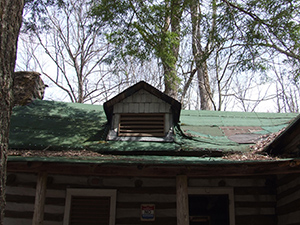
Figure 45. West (front) shed and dormer of the roof over Room 101. |
|---|
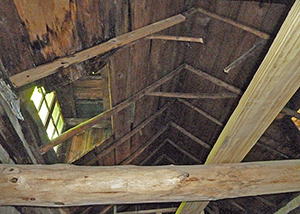
Figure 46. Roof over Room 101. |
Roof framing was designed to be exposed and, in keeping with the rustic style, pole rafters were used. The rafters are slender, 3” to 4" in diameter, lapped and nailed at the ridge, but without a ridge board. A shorter length of a slightly smaller pole is used as a collar tie at each pair of rafters, but many of these are either broken or missing entirely. At the gables, top logs extend 24" beyond the wall of the house. Eaves on the south and east sides of the cabin are 10" deep. The eaves at the north end of the kitchen are 12" deep while those at the north end of the north log pen are 16" and those around the front porch are 14".
It is not clear that the two dormers are original features, although they probably are. Patterns of paint on the underside of the roof decking in both dormers indicate the use of salvaged boards, which could have been the result of roof repair.
The gables are framed with five sawn, nominally 2" by 4" studs, nailed at the top to the rafter and at the bottom to the top log in the wall. Sawn nominally 1" by 6" boards installed horizontally across the studs act as lath for attaching the wood shakes that finish the exterior of the gables. The east to west gables feature decorative king-post trusses constructed with slender 2" to 3" diameter poles.
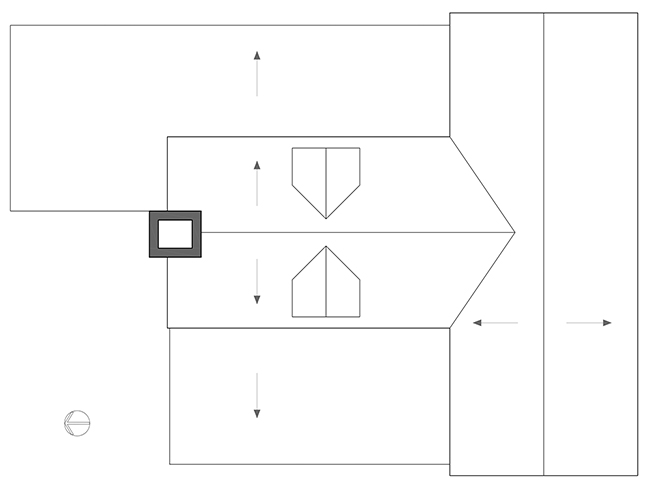
Figure 47. Roof plan of Fulton-Sneed Cabin. (Oppermann and Associates) |
|---|
The roofs are decked with nominally 1" by 6" boards, butted to one another to form a closed deck. The patina of the wood suggests that most of the decking on the gabled roofs is original. Decking and rafters on the back porch have been recently replaced.
The closed deck is probably the best indication that the original roof covering was not wood shingle, which is typically installed over an open deck. The 1931 appraisal notes roll roofing in its replacement costs, a good indication that roofing has always been roll asphalt. The existing asphalt roof covering is green as is an earlier layer or layers visible in a few locations.
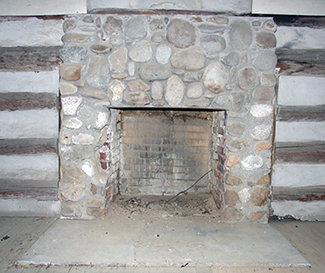
Figure 48. Fireplace in Room 101. |
|---|
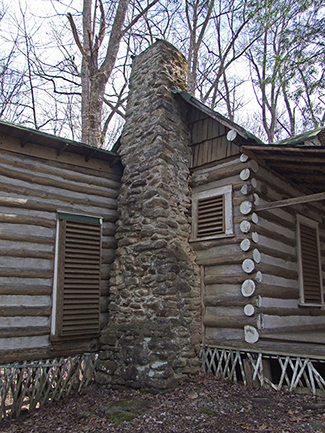
Figure 49. Chimney at north end of cabin. |
Chimney
Located at the north end of the house and serving a single fireplace, the chimney is rubble built using native stone and a hard, Portland mortar. The base is approximately 48" north to south and 61" east to west but larger stones are used to buttress the chimney, making the footprint of the chimney approximately 5' by 5'.
The chimney breast rises in an opening in the log wall that is around 48" wide by 45" high, created by sawing out the logs and nailing 1" by 6" or 8" boards to the sawn ends to create jambs for the opening. On the exterior, the chimney narrows above the opening and continues upward on the outside of the house between the two windows on that wall, terminating around 24" above the ridge of the roof. A simple, half-barrel chimney cap, probably galvanized steel, visible in 1993 images, is no longer present.
The kitchen originally used a wood- or coal burning stove set in the southwest corner of the room. It was vented with what must have been a standard 4" metal flue, which was run through the wall and into the chimney, just a few inches away. When the flue was removed, both openings were filled with cement.
Floors
Typical of many log buildings, sawn lumber was used to frame the floors in the Sneed Cabin. Lumber was likely cut locally and milled at the Elkmont sawmill. Floor joists for the original log pens are typically 1¾" by 7¾" laid north to south and set on 24" centers in the south pen, and laid east to west and set on 26" to 30" centers in the north pen. In the added kitchen pen, floor joists run east to west and are set on 24" centers.
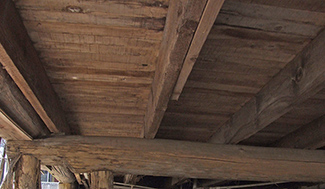
Figure 50. Looking south beneath the back porch, showing typical beam, joists, and flooring. |
|---|
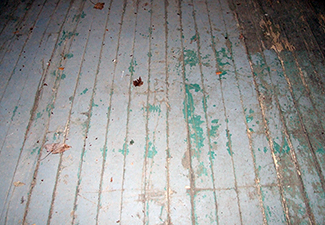
Figure 51. Typical flooring installed when the house was built. |
Floor joists for the front porch are typically 1¾" by 7¾" laid north to south and set on 24" centers. For the rear porch, the joists are also 1¾" by 7¾" laid north to south but set on 26" centers. Traditionally, floor joists were let into mortises in the sills, but the builder of the Sneed Cabin took a shortcut by utilizing a nominally 2" by 4" ledger nailed to the lowest log, which the joists were then sawn to lap while leaving a sort of sawn tongue extending between the logs. The floor joists appear to be in generally sound condition.
Original flooring is sash-sawn pine, tongue-and-groove, blind-nailed boards with an exposed face 3¼" wide. Flooring appears to have always been painted in shades of gray and green. Much of the flooring remains in place and in sound condition, but about a third of that on the east side of Room 101, 15% on the west side of Room 102, three boards in front of the door to Room 105, and five or six square feet around the wall separating the southwest corner of Room 101 from the northwest corner of Room 103 have been replaced with new flooring that matches the original. Sheets of composite board replace the original tongue-and-groove flooring where the bathroom is now located.
Flooring is in mostly good condition, although the floor covering in the bathroom may conceal hidden damage. The painted floor finish on original flooring is in poor condition, and the new flooring has not been painted at all. Hidden damage might also be expected along the west side of Room 102, where there have already been repairs
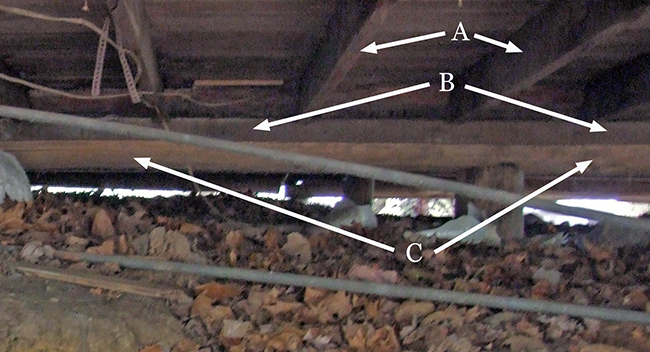
Figure 52. Typical joist (A), ledger (B), log sill (C) connection on the west side of Room 101. |
|---|
Porches
The front and back porches at the Sneed Cabin appear to be original features and have similar dimensions. The front porch deck measures 20'-5" north to south and 9'-10" east to west. The porch measures 20'-0" north to south and 8'-6" east to west.
The front porch is 12" to 13" above grade at the front entrance, and the single step, perhaps 6' or 7' wide, that eased entrance is now missing. Around the north end of the porch, the porch deck ranges between 26" and 30" above grade. The lowest log on the north wall of the house also forms one of two log beams, running east to west and resting on the log sill that runs north to south across the front of the porch. Sawn joists, nominally 2" by 8" and on 24" centers, run north to south between the beams. All of the front porch flooring, which runs east to west, has been replaced with tongue-and-groove flooring with an exposed face 3¼" wide, presumably matching the original flooring. The replacement flooring has not been painted. Green and gray paint on the logs suggest the historic color of the flooring, which was probably always kept painted. The paneled balustrades and wooden awning have been removed and all but one of the original log posts have been replaced. Only the post at the northwest corner of Room 103 remains in place.
The historic character of the back porch appears to be at least partially documented in Figure 40, which shows sawn wooden posts across the east side, with screening above tongue-and-groove paneling, similar to that used on the front porch. That enclosure is now missing. The south half of the floor, including joists and flooring, was recently replaced, presumably in conjunction with the roof repairs noted above. The screen door, outside landing, and steps to the ground that were historic features are missing. The floor is framed with a continuation of the log sill running across the east side of Room 105. There are three splices in the sill: one near the center of that room and two others at each of the two posts that support the outside edge of the porch. It is not clear which of these sections is original material. Sawn 2" by 8" joists on 24"-26" centers run east to west between that sill and the sill at the east side of Room 101. Tongue-and-groove flooring runs north to south and has an exposed face 3¼" wide, typical of all of the flooring in the house. A 7" log header for the rafters of the porch's shed roof is set on nominally 2" by 4" posts. The south end of the header has been replaced; the replacement timber was cut slightly too long for the space, leaving the top of the wall with an outward cant of several inches. Exposed pole rafters, 4" to 6" in diameter set on 24"-28" centers, complete the roof framing. Closed decking uses nominally 1" by 6" boards. The south wall of the back porch is formed by the log wall of Room 105. Remnants of electrical wiring, most of it Romex, remain on the wall, but the breaker box that once connected them is now gone. As noted above, significant rotting of the logs has occurred where that equipment was located. The north wall of the porch was originally open but was enclosed by the present vertically installed, tongue-and-groove boards for the kitchen (below), blind nailed to the outside of the cross header at that end of the porch.
A length of nominally 2" by 4" lumber has been added below the original cross header and four nominally 1" by 6" boards installed vertically to the left (west) side of the kitchen door. Those boards are not painted, unlike all of the historic millwork in the house, and they were apparently not part of the recent repairs. At the southeast corner of the porch is a trio of shelves, each 1" by 11" with clipped outside corners, painted green, and supported by a 1" by 2" wooden cleat nailed to the log wall and a 1" by 2" angle brace at the outside corner. The top shelf is set at 6'-1" above the floor; the middle shelf is about 14" below the top shelf, with the lower shelf around 21" below that. A single shelf remains at the south wall on the east side of the door; shadows in the painted wall suggest that there were originally at least four other shelves in that location.
Although both porches are in sound condition, the historic character of the Sneed Cabin was severely compromised by the some of the alterations that occurred during the course of recent repairs. These include removal of the log posts, pole brackets, and paneled balustrades from the front porch, which occurred after 1993. The header for the front-porch rafters is now comprised of two nominally 2" by 4" pieces of lumber set on edge; they appear to have replaced an original log header. At the northeast corner of the front porch, paint has left a "ghost" of the railings at that end of the porch. On the back porch, the railing is incomplete, with the paneled balustrade, screen door, landing and stairs to the ground no longer present.
Exterior Doors
The cabin has four exterior door openings. Three of the four doors that hung in those openings remain in the house, but only the south door in the kitchen is still hanging. The fourth door is missing.
The main entrance, via the front porch, is on the west side of Room 101. The framed opening is 3'-0" by 7'-0", and although the historic door remains in the house, it has been removed from this opening. The front door is a factory-made door, 1⅜" thick and typical of the first quarter of the twentieth century. It has three horizontal panels, raised on both sides, below four, nearly square, glass lights. The front door opened inward and was hung on a pair of unusual five-knuckle hinges mounted to the south jamb. The two-knuckle jamb portion of the hinge, which remains in place, is a 2" by 4" rectangle mortised into the jamb and attached with three screws. The other half of the hinge is surface-mounted to the interior face of the door, which is apparently how the hinges were designed to be installed. The hinge pins are missing. The original mortise lock remains on the door along with the stamped-metal escutcheon on the door's interior face. The escutcheon is oval, about 6¾" by 2¼", with a raised, flat center oval and a ribbon-and-bead border. The doorknob spindle, knobs, and the escutcheon on the exterior face of the door are missing. The escutcheons most likely matched. An early twentieth-century, cast-iron, rim lock, about 2⅝" by 3½", remains on the door. It could have been added anytime in the second quarter of the century. A pair of brackets for a curtain rod are mounted on the inside of the top rail. A modern hasp for a padlock is also mounted on the door. Three 3½" by 3½", surface-mounted hinges for a screen door are mounted on the south jamb of the front doorway and two on the north jamb of the back doorway. The hinges are similar to those that remain on the screen door in the kitchen (below), but the screen door itself is missing. The jambs for the front door are 6½" wide and probably nailed directly to the log ends. The doorway is cased on the exterior with plain 1⅛" by 4⅜" boards with a 1" by 2" drip cap. The imprint of a horseshoe, with the ends up, is visible in the paint at the center of the header.
The door opening from Room 101 to the back porch, which is on the east wall opposite the front door, is the same size and has the same trim as the front doorway, except that the back doorway has no exterior drip cap. The back door itself has not been located, but the 4" hinges and door were removed prior to the last time the door jamb was painted sometime in the late twentieth century. Two 3½" surface-mounted hinges for a screen door are mounted on the north jamb of the back door; as at the front door, there was apparently never a third hinge. A metal keep for a latch remains on the south jamb. The door at the north end of the back porch is a 2'-6" by 6'-5" by 1". It has four vertical panels separated by a fifth horizontal panel, a common pattern in the first quarter of the twentieth century. The door is hung with a pair of 3" butt hinges and has a mortise lock but no knobs, spindle or escutcheon. The door now swings outward but it may have originally swung inward and been hinged on the opposite jamb. A hook-and-eye latch is mounted high on the east jamb. The door on the west side of the kitchen is also 2'-6" by 6'-5" by 1" with four vertical panels separated by a fifth horizontal panel, but it has been taken down and the opening closed with a fixed louvered covering. The door retains a pair of 3" by 3" hinges, mortise lock, knobs, spindles and escutcheons. Heavy wooden brackets mounted on the inside casing held a cross bar to secure the door. Empty mortises on the south jamb suggest that the door was originally hung on that side of the jamb, reversing the present swing of the door. Also detached from the opening but still in the house is a screen door. The 3" hinges, which are similar to those that remain at the front door, remain on the screen door. All of the exterior doors have been removed from their frames. The front door and one screen door remain stored in the cabin, but the back door and the screen door for the front door are missing. Knobs and spindles have disappeared from the front door and from the door at the north end of the back porch. Both of the remaining doors and all casing and trim need minor repairs and repainting
Windows
In addition to the windows in the dormers described above, the Sneed Cabin has twelve window openings fitted with a variety of wooden sash. Sash on the front of the house and in the front gable have been replaced by louvered blinds, part of the park's effort to mothball the house, but most of the historic sash remain inside the house.
There are six double-sash window openings in the house, one in Room 101, two in Rooms 102 and 105, and one in Room 106. The two on the front of the house and the single one on the north side of the kitchen are 2'-9" by 5'-2"; those on the south and east are 2'-5" by 4'-6". Each window has two sash, each with a pair of vertical lights. The windows are "single-hung," i.e.., the top sash is fixed, the lower sash is counter-weighted with cast-iron weights hung with cotton rope, typical of the early twentieth century. Original hardware, much of which remains in place, includes a single, base metal, thumb lift at the center of the bottom rail of the lower sash and a conventional metal sash lock. Window casing is 1⅛" by 4⅜"; sills are 1½" thick and extend 1" beyond the front face and outside edge of the casing. Header casing is topped with a 1½" wooden drip cap. Above this is a sloping layer of cement instead of flashing. All of these windows were fitted with top-hung, wood-framed screens, but only two of those remain in place.
High on the north wall of Room 101, small four-light, fixed-sash windows flank the fireplace. Each is 2'-0" by 2'-2". The south end of the west wall of the kitchen addition intersects the window on the east side of the chimney. The small window openings high in the east and west gables are around 1'-10" by 2'-0". Each is now fitted with a fixed, wooden louver. The original fixed, four-light sash are among those now stored in Room 101.
The gable windows and the windows flanking the fireplace use a 3½" casing and 1½" sill like that used on the double-sash windows but do not have wooden or cement drip caps. Each of the dormers is fitted with a pair of similar fixed, four-light sash, arranged side by side.
The present bathroom window is entirely modern, and although there is no physical evidence for window sash in the present opening, record photographs from the 1990s show the window with a single six-light sash, the only such sash in the house. The present opening measures 2'-8" wide and 2'-3 high and now has a fixed wooden louver similar to those installed elsewhere on the house. Window casing is 1⅛" by 4⅜"; sills are 1½" thick and extend 1" beyond the front face and outside edge of the casing. There is no drip cap.
Across the east wall of the kitchen is an opening 9'-0" long and 2'-3" high. A series of four sash, each with two vertical lights, is mounted in tracks in the wooden frame. Plain nominally 1" by 5" boards provide an exterior casing but there is no outside sill or drip cap. Screening, stapled to the exterior face of the casing, covers the entire opening.
As with the doors, many of the window sash have been removed from their frames but remain in the house. Casing has been removed from one of the kitchen windows, but is still in the room. All of the windows, casing, and trim need minor repair and painting.
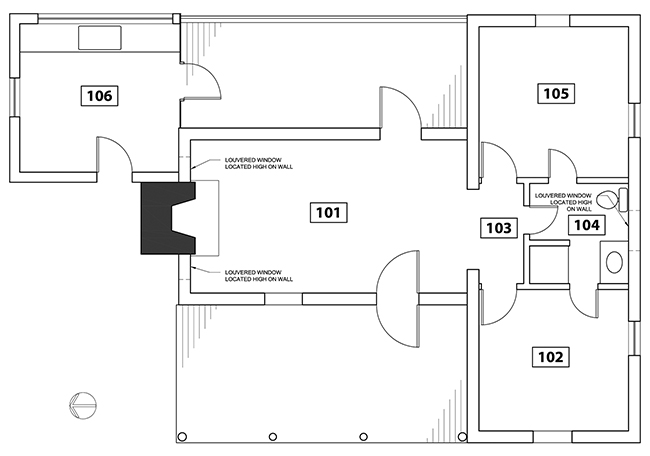
Figure 67. Floor plan of building. (Joseph K Oppermann, 2014) |
|---|
Room Descriptions
The house has six rooms, which includes a large living room (Room 101), two bedrooms (Rooms 102 and 105), and the kitchen (Room 106), plus a cross hall (Room 103) and modern bathroom (Room 104).
Room 101: Living Room
This room occupies one of the original log pens and has always functioned as the house's main living room. Entry is from the front or rear porches through the exterior doors described above. This room connects through a wide cased opening, 5'-7" by 7'-2", on the south to the cross hall (Room 103) between the bedrooms (Rooms 102 and 105).
Floor: The room is floored with the typical 3¼"-wide flooring. Floor area measures 11'-0" east to west by 19'-4" north to south. Original flooring is painted, with both grey and green showing in the badly worn finish. Areas along the east side that have been recently repaired remain unpainted.
Walls: The walls are the exposed logs of the log pen.
Ceiling: The room has no ceiling and is open to the pole rafters described above. The series of seven log joists, 7" to 8" in diameter, that span the room east to west are set at irregular intervals and heights. The log joist closest to each end wall is structurally redundant, but the others act to tie the walls together. Height of the joists above the finished floor level varies between 7'-5" and 7'-7".
Loft: As noted above, a floored loft was not present in the original house, possibly because of the labor that would have been necessary to flatten the tops of the joists so that a more or less level floor might be installed. Probably in the fourth quarter of the twentieth century, the existing, roughly-framed landing was installed above the southeast portion of the room. Framed with nominally 2" by 4" lumber, it provides access to a loft that was accessed by cutting out the center section of the top two logs of the wall connecting the two pens and simply laying ¾"-thick sheets of plywood across the joists over the south log pen. Nominally 2" by 4" lumber was also laid across the log joists to provide support for the butt joints between the sheets of plywood. There is no evidence that a staircase was ever built, and a ladder provided access to the loft.
Doors: The doors are cased with the 1" by 4½" planks used as jamb casing on all three door openings but as header casing only at the large opening at the south end of the room. At the two exterior doors, 2½" drip cap turned on edge is used as header casing. All millwork is painted.
Windows: Windows are also cased with 1" by 4½", which is used at jambs and headers and as an apron. Window stools are plain ¾" by 2½". There is no header molding. All millwork is painted.
Fireplace: The fireplace at the north end of the room is constructed of brick and only veneered with stone. The opening, which has a 4" cast-iron lintel, is around 33" wide and 33" high, with the box itself around 22" deep. The canted side walls and the rear wall of the firebox are constructed with cream-colored firebrick. Extending into the room, the hearth is poured concrete supported by a wooden frame between the floor joists below. The hearth, which is badly cracked, measures about 23½" by 63½" and 6" to 8" thick. Its surface may have originally been flush with the finished floor, but deflection of the floor has left the front of the hearth nearly 1" higher than the surrounding flooring.
Electrical System: A keyless porcelain light fixture is mounted at each end of the room, with a switch by the front door. There is a single convenience outlet on the east wall. All of the wiring is surface mounted. None of it is operational.
Room 102: West Bedroom
This room is located at the west end of the log pen that forms the south side of the Sneed Cabin. It is entered via Room 103 or Room 104.
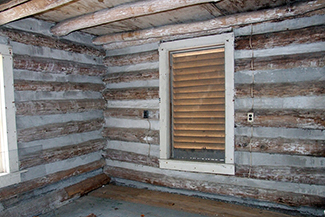
Figure 73. Looking southwest. |
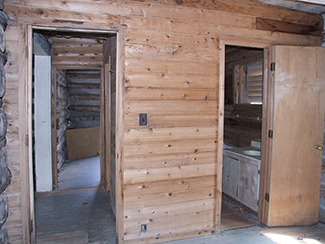
Figure 74. East wall. |
|---|---|
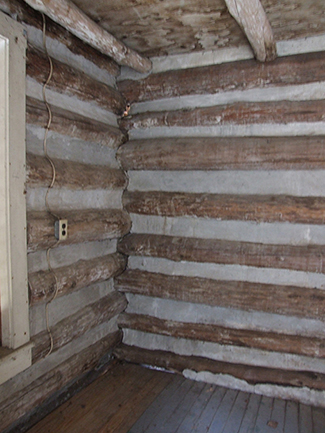
Figure 75. Looking northwest. |
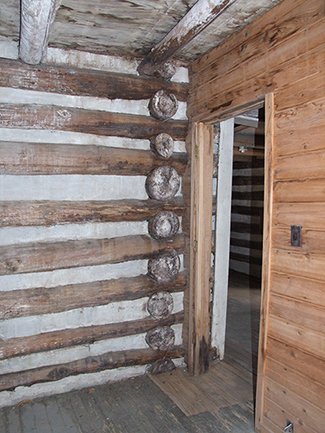
Figure 76. Looking northeast. |
Floor: The room is floored with the typical 3¼"-wide flooring. Floor area measures 10'-0" east to west by 10'-7" north to south. Original flooring is painted, with both grey and green showing in the badly worn finish. Areas along the west side and around the door to Room 103 have been recently repaired and remain unpainted. About 15% of the flooring on the west side of the room has been replaced in conjunction with recent repairs, which included replacing 32" of the floor-level log on the south side of the room.
Walls: The north, west, and south walls are formed by the exposed walls of the log pen itself. The east wall is wood framed and finished with ¾" by 5½" V-joint, tongue-and-groove, cedar paneling, all installed horizontally with ends cut to fit the log walls without added trim. It dates to the 1970s remodeling of the bathroom. Evidence for earlier walls is obscured by the modern bathroom. Much of the chinking on the west and south walls in this room has also been repaired and resurfaced, but not cleaned of the inevitable residue from the process.
Ceiling: The room has no ceiling other than the underside of the plywood laid across the tops of the joists. The series of four log joists, 7" to 8" in diameter, that span the room north to south are set at irregular intervals and heights. The log joist closest to the end wall is structurally redundant, but the others act to tie the walls of the log pen together. Height of the joists above the finished floor level varies around 7'-8" It appears that the log joists and the plywood flooring in the attic were at one time painted white.
Doors: The two doors, both on the east wall, are part of the modern bathroom addition. Both are hollow-core, flush doors, 1⅜" thick. The door to the hall (Room 103) is 2'-6" by 6'-8"; the door to the bathroom (Room 104) is 2'-0" by 6'-8". Both are hung with three 3" hinges and have brass-plated doorknobs with privacy latch and plain round escutcheons, all typical of the period. Both are cased with plain ¾" by 2½" cedar boards.
Windows: There are two windows in this room, one on the west wall and one on the south. The double-sash window on the west wall is the typical 2'-9" by 5'-2", but the sash have been replaced by a fixed louver. The double-sash window on the south wall is slightly smaller, 2'-5" by 4'-6" and is one of the few windows to retain all of its historic features, including sash, trim, and hardware. Both windows have cast-iron counterweights for the lower sash and the same 1" by 4⅜" casing and apron used elsewhere in the cabin. Brackets for curtain rods are attached at the top corners of the windows.
Electrical System: A keyless porcelain light fixture is mounted on a log joist at the center of the room, switched at the door to Room 103. Convenience outlets are mounted about 4' above the floor on each side of the window on the west wall. All wiring is surface-mounted, except on the east wall where wiring for the switch is concealed in the wall.
Room 103—Cross Hall
As already noted, this space dates to the 1970s remodeling, and possible expansion, of an earlier bathroom. Room 103 is a cross hall connecting the living room (Room 101), bedrooms (Rooms 102 and 105) and bathroom (Room 104).
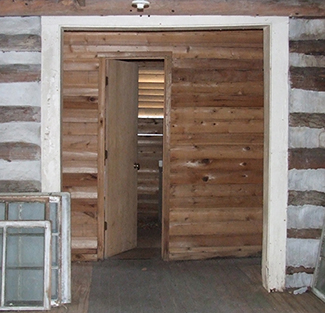
Figure 77. Cross hall as seen from Room 101. |
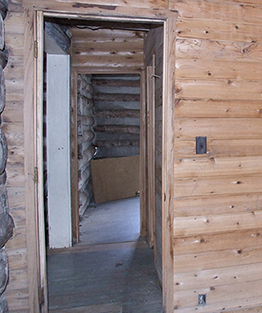
Figure 78. Cross hall, looking from 102 to 105. |
|---|
Floor: About 40% of the flooring is the original, painted, tongue-and-groove boards continuing from Room 101. The remainder, located around the doorways to the adjacent bedrooms is matching new flooring that remains unpainted. Floor area measures 7'-1" east to west and 2'-11" north to south.
Walls: The north wall of Room 103 is the original log wall of the cabin. The other three walls are wood-framed and covered like the ceiling with ¾" by 5½" V-joint, tongue-and-groove, cedar paneling. At the wall corners and at the juncture of the walls and ceiling, ¾" quarter-round molding is used as trim. Simple ¾" by 3½" cedar boards form the baseboards.
Ceiling: The finished ceiling is at 7'-6" above the finished floor and uses the typical ¾" by 5½" V-joint, tongue-and-groove, cedar paneling, running north to south.
Doors: Unpainted, flush doors on the east, west, and south walls of Room 103 connect to the bedrooms (Rooms 102 and 105) and bathroom (Room 104) and are part of the modern bathroom remodeling. All three are hollow-core, 1⅜" by 2'-6" by 6'-8" doors, hung with three 3" hinges and have brass-plated doorknobs with privacy latch and plain round escutcheons, all typical of the third quarter of the twentieth century. All of the doors are cased with plain ¾" by 2½" cedar boards, excepting the large cased opening connecting Rooms 101 and 103. The frame for that opening is 7" wide and is cased with 1" by 4½" planks, painted white.
Room 104—Bathroom
This bathroom dates to the 1970s and may be an expansion of an earlier bathroom. Entry is from Room 102, 103, and 105.
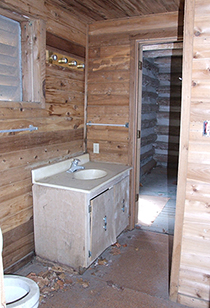
Figure 79. Looking southwest. |
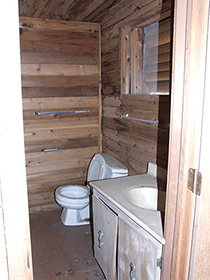
Figure 80. Looking southeast. |
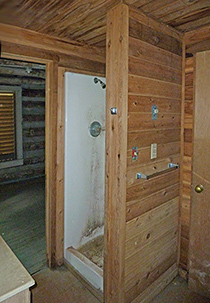
Figure 81. Looking northwest. |
|---|
Floor: The original tongue-and-groove flooring remains in this room but is now covered by a masonite floor covering. Floor area, including the shower, measures 7'-1" east to west and 7'-0" north to south.
Ceiling: The finished ceiling is at 7'-6" above the finished floor and uses the typical ¾" by 5½" V-joint, tongue-and-groove, cedar paneling, running north to south.
Walls: The south wall is the original log wall of the cabin, while the other three walls are wood-framed. All four walls are covered like the ceiling with ¾" by 5½" V-joint, tongue-and-groove, cedar paneling. At the wall corners and at the juncture of the walls and ceiling, ¾" quarter-round molding is used as trim. Simple ¾" by 3½" cedar boards form the baseboards.
Doors: Unpainted, flush doors on the east, west, and north walls connect to the bedrooms (Rooms 102 and 105) and the cross hall (Room 103).
Windows: The room has a single window opening, located in the middle of the south wall. The opening measures 2'-8" wide by 2'-3" high and is fitted with a modern louver like those used elsewhere in the cabin. Figures 36 and 38 show the six-light sash that the louver replaced.
Electrical System: A modern, four-socket, light fixture is mounted above the sink, with a switch near the door to Room 103. Ceiling mounted fixtures light the shower area and are also switched near the door to Room 103. A heat lamp is mounted two feet in front of the window, with its own rheostatic control on the wall above the light switches. One convenience outlet is mounted on the west wall just above the lavatory. All wiring is concealed.
Plumbing Fixtures: A fiberglass shower approximately 30" by 30" is located in the northwest corner of the room. A wooden cabinet base with a molded sink and top is located in the southwest corner. In the southeast corner of the room is an American Standard toilet with a 4049 tank. The date stamped in the lid of the tank, which can be a reliable indicator of the date of installation, is illegible.
Room 105—East Bedroom
This room is located at the east end of the log pen that forms the south side of the Sneed Cabin and is entered via the cross hall (Room 103) or the adjacent bathroom (Room 104). It measures 10'-8" east to west by 10'-6" north to south.
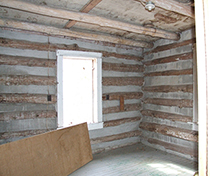
Figure 82. Looking southeast. |
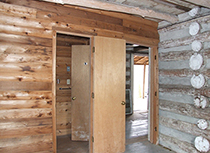
Figure 83. Looking northwest. |
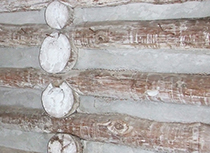 Figure 84. North wall and intersecting wall. |
|---|
Floor: The room is floored with the typical 3¼"-wide flooring, but, as noted above, with some replacement with matching, but unpainted, flooring around the hall door.
Ceiling: The room has no ceiling other than the underside of the plywood laid across the tops of the joists, with nominally 2" by 4" lumber laid flat where the plywood sheets are butted to one another. The series of four log joists, 7" to 8" in diameter, that span the room north to south are set at irregular intervals and heights. The log joist closest to the end wall is structurally redundant, but the others act to tie the walls of the log pen together. Height of the joists above the finished floor level varies around 7'-10".
Walls: The north, east, and south walls are formed by the exposed walls of the log pen itself. The west wall is wood framed and finished with ¾" by 5½" V-joint, tongue-and-groove, cedar paneling, all installed horizontally with ends cut to fit the log walls without added trim. It dates to the 1970s remodeling of the bathroom. Evidence for earlier walls is obscured by the modern bathroom.
Doors: The two doors, both on the west wall, are part of the modern bathroom addition. Both are hollow-core, flush doors, 1⅜" thick. The door to the hall (Room 103) is 2'-6" by 6'-8"; the door to the bathroom (Room 104) is 2'-0" by 6'-8". Both are hung with three 3" hinges and have brass-plated doorknobs with privacy latch and plain round escutcheons, all typical of the period. Both are cased with plain ¾" by 2½" cedar boards.
Windows: There are two windows in this room, one on the east wall and one on the south. Although the east window is missing its typical two-over-two sash, both were originally double-sash windows, 2'-5" by 4'-6", each fitted with cast-iron counterweights for the lower sash. The window on the south wall retains all of its historic features, including sash, trim, and hardware. Both windows have the same 1" by 4⅜" casing and apron and 2½" stool used elsewhere in the cabin. Brackets for curtain rods are attached at the top corners of the windows.
Electrical System: A keyless porcelain light fixture is mounted on a log joist at the center of the room, switched at the door to Room 103. Similar to Room 102, convenience outlets are mounted about 4' above the floor on each side of the window on the east wall. All wiring is surface-mounted, except on the west wall where wiring for the switch is concealed in the wall.
Room 106—Kitchen
This room was built as a kitchen, probably in the 1920s. The decision-making process in developing its rather awkward design is not clear, but may have been simple practicality. The shed roof is a continuation of the shed roof over the back porch but is continued upward on the west side to give height to what would have been a rather low ceiling otherwise.
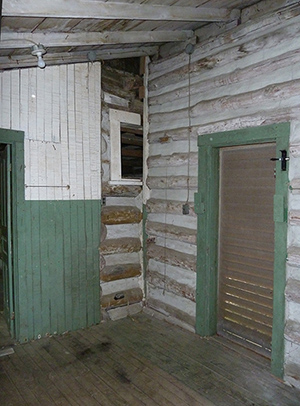
Figure 85. Looking southwest. |
|---|
Floor: The room measures 10'-10" east to west and 11'-4" north to south. The flooring is laid north to south on sawn 2" by 8" joists, set on 24"-28" centers. Flooring is typical tongue-and-groove planks with an exposed face 3¼" wide. Part of the flooring here is painted, but an area about 8' by 8' in the center of the floor is not painted, probably because of a linoleum "rug" laid on the floor. Small remnants of a late-twentieth-century vinyl floor covering remain in places around the perimeter of the room.
Walls: As noted above, this room is essentially a three-sided log pen, with its fourth wall created by a board wall at the north end of the original back porch. The west or front wall is log, rising to 10'-4" above the finished floor. Although similar to the original construction, the logs used in this room are significantly smaller, averaging only 5" to 6" in diameter. The east or rear wall is log as well, but rises only to around 7'-3". The north wall is also log, joined to the west and east walls with the saddle notching typical of the original structure. Because of the slope of the roof, the top three logs on the north wall do not extend the full width of the wall but are held in place by wooden cribbing and the cement chinking. The south wall, adjoining the back porch, is a board wall consisting of 3½" tongue-and-groove boards with an exposed face 3¼" wide. The boards are nailed to the end rafter, to the side header beam from the original porch, and to a wooden cleat 2" by 2" nailed to the floor. Individual boards do not run floor to ceiling, and there is a horizontal seam visible where shorter lengths were used to finish the wall above the header.
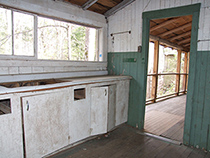
Figure 86. Looking southeast. |
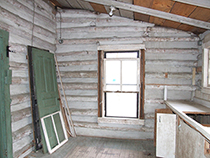
Figure 87. Looking north. |
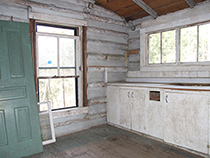
Figure 88. Looking northeast. |
|---|
Ceiling: The exposed rafters are nominally 2" by 4" set on centers 28" to 30" apart. They lap the top log on the east wall and extend about 12" on the exterior. The ceiling is the underside of the 1" by 11" used for the closed roof decking, much of which has been replaced on the east side of the room.
Doors: The exterior door opening on the west wall retains all of its original elements, but the five-panel wooden door (2'-6" by 6'-5" by 1") and its accompanying screen door have been removed from the frame. The exterior door opening on the south wall retains its original elements as well, but as noted earlier the five-panel door (2'-6" by 6'-5" by 1") has been altered.
Windows: The double-sash, two-over-two window on the north wall, which is 2'-9" by 5'-1", remains in place but the 1" by 5" jamb casing and the lower sash have been removed and placed in the corner of the room. Two of the four two-light sash in the sliding windows on the east wall have also been removed but the plain 1" by 3¼" casing remains in place. The 2½" window stool remains at both openings as well.
Electrical System: A keyless porcelain light fixture is mounted on a log joist at the center of the room, switched at the door to the back porch. A modern 220-volt outlet for an electric range is located in the southwest corner of this room.
Other Features: As noted earlier, a patch in the upper part of the north wall and a corresponding patch in the east face of the chimney mark the location of the original wood- or coal-burning stove. A wooden base cabinet typical of the late twentieth century occupies the entire east side of the room. It is probably contemporaneous with the bathroom remodeling. A double-basin sink has been removed along with the supply and waste lines. Two drawers are also missing.
Utility Systems
It is not clear if any utility systems were present in the original house. As discussed earlier, there is historical documentation to suggest that at least some of the cabins had electric lights and running water by 1914. Propane gas was introduced in the mid-twentieth century.
Plumbing
The original cabin may have depended on a privy, but sinks might have been installed in the bedrooms at an early date. Historical documentation suggests that a bathroom and kitchen were present by 1931. This probably included wall-hung, cast-iron sinks, all of which have been replaced. The only elements of an early plumbing system are the stubs of cast-iron waste lines under the bathroom. A tangle of galvanized-steel piping is located under the northwest corner of the porch. While early water lines were probably similar, the character of these pipes and their connections suggest that they could have been lines to supply propane gas to space heaters inside the house. All of the present, above-grade water supply and waste lines use PVC pipes, but there is no longer any water service to the house. The cast-iron vent stack that ran exposed up the south side of the house has been removed.
Electrical System
There is no evidence in the Sneed Cabin for an early, knob-and-tube wiring system, such as that found in some of the other cabins. The earliest wiring observed has cloth insulation impregnated with fire- and moisture-resistant compounds, typical of the mid-twentieth century. Later wiring is modern Romex wiring with plastic insulation. Two generations of junction boxes are also evident, but both are galvanized steel and similar in design. Two generations of cover plates are present as well, one brown with a striated surface and the other ivory with a smooth surface. Interior lighting was provided by bare bulbs in keyless porcelain fixtures. These were served by surface-mounted wiring and switched in the conventional manner. A single mid-twentieth-century exterior floodlight remains at the north end of the kitchen. A similar fixture was present at the west gable in 1993 but has since been removed, and a short length of pipe in the east gable suggests that a similar fixture was present there as well. There is no longer any electrical service to the cabin. The breaker panels or fuse boxes at the south end of the back porch have all been removed.
Character-Defining Features
Most of the cabin's present features and materials date to the Elkmont Historic District's period of significance, 1908-1940, as defined in the National Register Nomination for the Elkmont historic district. The loft and the cedar paneling and other features and materials associated with the present bathroom are outside that period but may conceal evidence of now-missing historic features and materials.
Important character-defining features include:
- The proximity of the cabin to the other summer houses within the Appalachian Club Complex and to the clubhouse.
- The densely wooded site at the top of the ridge.
- The stone retaining walls, steps, and walkway on Daisy Town Road.
- The shared concrete steps off the southeast corner of the house.
- The log walls of the cabin.
- The wood-shingled gables and decorative trusses.
- The pole-rafters exposed on the interior.
- The open front and rear porches.
- The gable roofs and dormers over the main house structure.
- The shed roofs over the porches and the kitchens.
- The log posts and stacked stone piers of the foundation.
- The wood lattice enclosing the foundation on all sides.
- The river stone fireplace and chimney.
- The three-panel and four-light front door.
- The two five-panel exterior doors to the kitchen.
- The two-panel screen door at the door on the west side of the kitchen.
- The early door and window hardware throughout the cabin.
- The two-over-two-light, double-sash, counterweighted, wood windows.
- The fixed, four-light sash in the gables, the dormers, and flanking the fireplace.
- The 3¼” tongue-and-groove wood flooring throughout most of the cabin.
- Ceramic lamp bases in each room of the cabin.
- The floodlight at the northwest corner of the kitchen.
Missing character-defining features that were present in 2001 include the wooden steps to the kitchen door and to the back porch; the paneled balustrades, log posts with pole braces, wooden awning and bench on the front porch; and the paneled balustrade and screening on the rear porch.
![]()
Notes
1. J. Randall Cotton, “Log Houses in America,” Old House Journal (Jan/Feb 1990), 38.
2. Population schedules, federal census, 1870-1940, and “Weston Miller Fulton Jr,” Findagrave.com.
3. Jack Neely, “Miracle on Third Creek,” The Zine, online.
4. “Weston Fulton,” Wikipedia.
5. Thomason and Associates, "The History and Architecture of the Elkmont Community" (Atlanta, GA: National Park Service Southeast Regional Office, 1993), 11.
6. Daniel L. Paulin, Images of America: Lost Elkmont (Mt. Pleasant, SC: Arcadia Publishing, 2015), 65.
7. Paulin, Lost Elkmont, 66.
8. Thomason, "History of Elkmont," 11.
9. Sevier County Deed Book 40, 546.
10. John William Leonard, Winfield Scott Downs, M. M. Lewis, “William Henry Schuerman,” Who’s Who in Engineering (John W. Leonard Corporation, 1922); Federal census 1850–1940; Carroll McMahan, “Upland Chronicles: Millionaire’s Row offered idyllic summer respite,” The Mountain Press.com. His grave has not been located.
11. Ibid.
12. Leonard, et al., omit mention of Schuerman’s first marriage, which is documented in the Federal census schedules.
13. “Leonora Criddle,” <http://www.littletownmart.com/family/ Genealogy.asp?2690>. The Federal census 1850-1940 provides other details of her life.
14. McMahon, “Upland Chronicles: Millionaire’s Row.”
15. Appraisal-summary cards are online at the Sevier County History Center website, < http://history.sevierlibrary.org/Park%20land%20files/ Index%20Page%20land.htm>. The location of the original cards is not known. In spite of the confusion of information on the Schuermans’ cards, a search of the appraisals for the other cabins in Daisy Town supports the assumptions in the present narrative. The appraisal cards provide the only documentation found for the name of the Schuermans’ cabin on Millionaire’s Row.
16. Ibid. In the estimates for replacement costs for the log cabin on Daisy Town Road, the value of the plumbing is the third largest component. There was already water and sewer in the street in Daisy Town.
17. Ibid.; Sevier County Deed Book 64, 526.
18. National Park Service, “Elkmont Historic District, Draft Environmental Impact Statement and General Management Plan Amendment, Vol. 1” (January 2006), S-2.
19. TRC Garrow Associates, Inc., “Cultural Resources of the Elkmont Historic District, Great Smoky Mountains National Park, Sevier County, Tennessee,” Appendix 3 (draft report, 2002).
![]()
Sources of Information
Cotham, Steve. Images of America: The Great Smoky Mountains National Park. Mt. Pleasant, SC: Arcadia Publishing, 2006.
Cotton, J. Randall. “Log Houses in America,” Old House Journal, Jan/Feb 1990.
“Future Management of the Elkmont Historic District.” Briefing Statement by National Park Service, January 27, 2010.
Guymon, Gail L. Draft National Register of Historic Places nomination, Daisy Town Historic District, Great Smoky Mountains National Park, 2010.
Leonard, John William, Winfield Scott Downs, M. M. Lewis, Who’s Who in Engineering Vol 1. John W. Leonard Corporation, 1922.
National Park Service, U.S. Department of the Interior. Elkmont Historic District. Final Environmental Impact Statement and General Management Plan Amendment. Vols. 1 and II. Gatlinburg, TN: National Park Service, 2006.
Oppermann, Joseph K. Addicks Cabin and Adamless Eden, Elkmont Historic District, Great Smoky Mountains National Park, Historic Structure Report. National Park Service Southeast Regional Office, 2010.
_______. Appalachian Clubhouse, Elkmont Historic District, Great Smoky Mountains National Park, Historic Structure Report. National Park Service Southeast Regional Office, 2009.
_______. Cain Cabin. Elkmont Historic District, Great Smoky Mountains National Park, Historic Structure Report. National Park Service Southeast Regional Office, 2014.
_______. Chapman-Byers Cabin, Elkmont Historic District, Great Smoky Mountains National Park, Historic Structure Report. National Park Service Southeast Regional Office, 2009.
_______. Creekmore Cabin, Elkmont Historic District, Great Smoky Mountains National Park, Historic Structure Report. National Park Service Southeast Regional Office, 2014.
_______. Higdon Cabin, Elkmont Historic District, Great Smoky Mountains National Park, Historic Structure Report. National Park Service Southeast Regional Office, 2015.
_______. Levi Trentham Cabin, Elkmont Historic District, Great Smoky Mountains National Park, Historic Structure Report. National Park Service Southeast Regional Office, 2010.
_______. Mayo Cabin and Mayo Servants’ Quarters, Elkmont Historic District, Great Smoky Mountains National Park, Historic Structure Report. National Park Service Southeast Regional Office, 2010.
_______. Smith Cabin, Elkmont Historic District, Great Smoky Mountains National Park, Historic Structure Report. National Park Service Southeast Regional Office, 2014.
_______. Spence Cabin, Elkmont Historic District, Great Smoky Mountains National Park, Historic Structure Report. National Park Service Southeast Regional Office, 2009.
Paulin, Daniel L. Images of America: Lost Elkmont. Mt. Pleasant, SC: Arcadia Publishing, 2015.
Thomason and Associates. "The History and Architecture of the Elkmont Community." Atlanta, GA: National Park Service Southeast Regional Office, 1993.
Thomason, Phillip and Dr. Michael Ann Williams, revised by Len Brown. National Register of Historic Places nomination; Elkmont Historic District, Great Smoky Mountains National Park, 1994.
TRC Garrow Associates, Inc. “Archaeological Investigations in the Elkmont Historic District, Great Smoky Mountains National Park, Sevier County, Tennessee.” National Park Service, 2005.
_______. “Cultural Resources of the Elkmont Historic District, Great Smoky Mountains National Park, Sevier County, Tennessee.” National Park Service 2004.
Yarbrough, Willard. “Early Days Recalled: Elkmont, Rooted in Smoky Park History, Is Proud of Tradition,” The Knoxville News-Sentinel, August 29, 1965.
Public Records
Sevier County Records of Deeds and Mortgages.
United States Federal Census, Population Schedules, 1850-1940.
Websites
Knoxville Lost and Found. <http:// knoxvillelostandfound.blogspot. com/2012_05_01_archive.html>
Little River Railroad and Lumber Company
Museum. <www.littleriverrailroad.org>
McMahan, Carroll. “Upland Chronicles:
Millionaire’s Row offered idyllic summer
respite,” The Mountain Press.com, <http://www.themountainpress.com/
opinion/localcolumnists/x1548110766/
Upland-Chronicles-Millionaire-s-Row-off eredidyllic-summer-respite>
Neely, Jack. “Miracle on Third Creek,” The Zine, <http://monkeyfi re.com/mpol/dir_zine/
dir_2000/1040/t_cover.html>.
“Purchasing of Property for the Great Smoky Mountains National Park.” Sevier County
History Center. Sevier County Public Library
System, Sevierville, TN,<www.sevierlibrary.
org>
![]()
